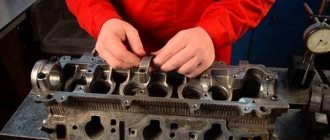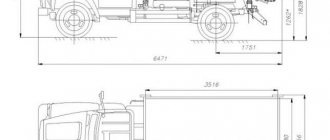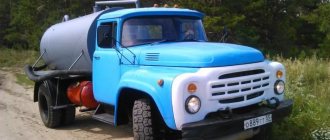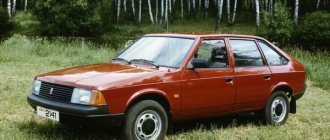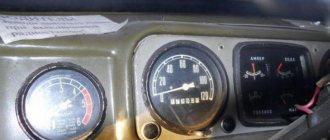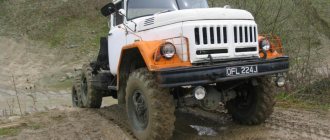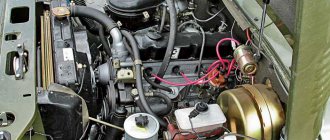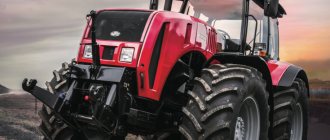Tire profile (height) for models of different years of manufacture.
Disclaimer: Although the data represents official manufacturer figures, the information above is for reference only and is not guaranteed to be absolutely accurate.
Since 1966, the plant has produced a 2.5-ton GAZ-52-03 car on a GAZ-51 chassis with a 75 hp engine. and a cabin from GAZ-53A. In 1975, it was replaced by the GAZ-52-04, which was a chassis with a cab from the GAZ-53A and the same 75-horsepower engine. It was offered in versions with an onboard platform and a chassis with a GAZ-52-01 and GAZ-52-02 cab with two wheelbase sizes (3300 and 3700 mm), like the SAZ-3503 dump truck, cargo-passenger taxis GAZ-52-05 and GAZ- 52-08, truck tractor GAZ-52-06. They were produced until the end of 1989.
SPECIFICATIONS
| 52-09 | ||
| Load capacity, kg | 2500 | 2500 |
| Curb weight, kg | 2685 | 2875 |
| Including: | ||
| to the front axle | 1305 | 1395 |
| to the rear axle | 1380 | 1480 |
| Total weight, kg | 5335 | 5525 |
| Including: | ||
| to the front axle | 1655 | 1755 |
| to the rear axle | 3680 | 3760 |
| Maximum speed, km/h | 70 | 70 |
| Control gas consumption at 60 km/h, l/100 km | 26 | 26 |
Engine
Modification GAZ-52-07 (basic GAZ-52-04, converted to run on LPG), power 54 kW (73 hp) at 2800 rpm, torque 196 Nm (20 kgfm) at 1600–1800 rpm.
Gas power system
The gas cylinder is mounted on the frame on the left side of the car. Maximum operating pressure 16 kgf/cm 2, useful volume 136 l, total volume - 151 l. The cylinder is equipped with a filling valve and two flow valves (steam and liquid phase), a fuel level indicator sensor, a filling device, safety and control valves. A two-stage gas reducer mol.-RZAA and a liquid gas evaporator are located in the engine compartment. Gas and gasoline fuel filters are equipped with RS-33601 solenoid valves to shut off the supply of gas and gasoline from the driver’s seat using the P-20A2 fuel type switch. Carburetor-mixer - K-126D, gas supply - through holes in diffusers. Gas pressure indicator - pressure gauge UK-1 30, located on the instrument panel. The MM-358 pressure sensor is located in the first stage of the gas reducer.
Car GAZ-52-27 4×2.2
Produced by the Gorky Automobile Plant on the basis of the GAZ-52-04 in 1984–1990. The main fuel is compressed natural gas (CNG), the backup fuel is A-76 gasoline.
SPECIFICATIONS
| Load capacity, kg | 2400 |
| Curb weight, kg | 2855 |
| Including: | |
| to the front axle | 1300 |
| to the rear axle | 1555 |
| Total weight, kg | 5405 |
| Including: | |
| to the front axle | 1640 |
| to the rear axle | 3765 |
| Maximum speed, km/h | 70 |
| Control gas consumption at 40 km/h, m 3 /100 km | 14,8 |
Engine
Modification GAZ-52-27 (basic GAZ-52-04, converted to run on LNG), compression ratio 7.0, power 48.5 kW (65 hp) at 2800 rpm, torque 182 N· m (18.6 kgf m) at 1600-1800 rpm.
GAZ-52 is one of the most produced medium-duty vehicles produced at the Gorky Automobile Plant (more than a million copies, excluding modifications). Despite the fact that the technical characteristics of the GAZ-52 demonstrate a hybrid version of the 51st and 53rd models, the car is interesting and unique in its own way.
Car history
The late 1950s and mid-1960s were management plans at the conveyor plant to produce three generations of trucks, which were unified among themselves. The base car was considered to be the new GAZ 52, which became the successor to the GAZ-51A truck, which also had a 4x2 wheel formula and a load capacity of 2,500 kilograms.
When creating the car, we tried to take into account that the main area of application of the truck would be urban transportation and operation in rural areas. Taking these points into account, the design features of the car should have ensured good maneuverability and fairly good cross-country ability along with a smooth ride, because asphalt roads were quite rare to find.
The creation of small and medium-tonnage trucks was necessary for the entire country, since it was undergoing a full-fledged process of restoring the national economy, which was destroyed during wartime, and also required the active construction of residential cities. There were simply very few cars that could operate in the city, and freight transportation as part of a road train did not develop either.
Therefore, the design staff was instructed to develop a project for a truck, which was initially intended for transporting various goods in the city and rural areas. There were versions of the GAZ 52 dump truck and on-board vehicle. Thus, a new model GAZ-52 was created on the GAZ 51 A platform, which had been produced since 1955.
A little later, the car was able to successfully replace the previous family. The new car stood out with a different cab, the design solution of which was somewhat similar to American trucks of the 1950s. In those years, many did not even imagine that this design would be in demand during all this time, and this is not much - no less - 30 years.
This is interesting: GAZ 3309: technical characteristics, dimensions, cabin
History of the plant
Until the end of the 20s, cars in the USSR were purchased abroad. In 1929, the government of the country decided to correct this situation. In the spring of this year, a decree was passed on the need to build a modern automobile plant.
The site for the new enterprise was found a month later. It was decided to build a new plant near Nizhny Novgorod, which was called Gorky from 1932 to 1990. The choice of the site next to this settlement was explained by the convenience of the location both in terms of geography and natural resources.
Since there was no experience in building automobile enterprises in the country at that time, it was necessary to invite world-famous engineers to develop the plant project. But, of course, Soviet specialists also took part in the construction of the new automobile enterprise.
Technical characteristics of GAZ-52
Dimensions and weights:
- Length – 5.7 m (6.395 m – long wheelbase version).
- Width – 2.28 m (23.8 m for long wheelbase).
- The height without cargo in the cabin is 2.15 m (21.9 m).
- The turning radius is 7.5 m (along the outer side of the front wheels).
- The maximum lifting angle with a full load is 15°.
- The loading height of the onboard platform is 1.21 m (1.28 m).
- The weight of the GAZ-52 with a body is 5.17 tons; for long-wheelbase vehicles (for example, the GAZ-52 fuel truck) the weight is slightly higher - 5.465 tons.
- How much does the GAZ-52 weigh without a body - 2.52 tons (2.815 tons).
- What is the maximum weight of the trailer - 2.5 tons.
- What is the carrying capacity - 2.5 tons.
Specifications
Power unit
After failures with the prechamber engine, it was decided to install the GAZ-52-01 engine on the 52nd model, which is a more powerful version of the engine of the 51st model. Motor characteristics:
- power – 75 “horses”;
- number of cylinders – 6, strokes – 4;
- engine type – carburetor, two-chamber;
- valve arrangement - in-line, bottom;
- volume – 3485 cm3;
- compression ratio number - 6.2;
- torque limit - 21 kgm in conditions of 1.6-1.8 thousand rpm;
- engine weight – 250 kg;
- cooling type – water.
Be sure to read: Renault Premium tractor: modifications, device
The crankshaft, cylinder block, crankcase and its ventilation filter, and air filter were taken from a GAZ-53. Such a forced engine is quite “gluttonous” (especially if you take into account the not too large volume of the tank - 90 liters): fuel consumption per 100 km is 20-21 liters (subject to driving in 4th gear on a good road). Therefore, “gas” versions are more popular.
Brake system
Service brake parameters:
- by the number of circuits - 1-circuit;
- drive – hydraulic, with hydraulic-vacuum booster;
- type of mechanism on wheels - drum.
The parking brake is transmission, equipped with a mechanical drive.
Transmission
Main characteristics:
- clutch – 1-disc, dry;
- number of gears – 4;
- the presence of synchronizers in 3rd and 4th gear;
- final drive ratio – 6.67 (6.83 on base versions);
- disc diameter increased to 28 cm.
Most of the elements were “borrowed” from the GAZ-51A: main and intermediate cardan, intermediate cardan support, sliding fork. The 52nd version gearbox is considered relatively silent and wear-resistant.
Chassis
The frame of modifications with an extended base is the same as that of the 53rd car (wheelbase 3.7 m). The “short version” (wheelbase - 3.3 meters) is characterized by side members with reduced cross-sections. Frame weight – 197 (270) kg. “Innovations” affected the suspension: now the ends of the earless springs were embedded in rubber cushions, which reduced the load on the main sheets. The springs are equipped with 0.5-elliptical, longitudinal, rear suspension is devoid of shock absorbers, but has an additional spring.
GAZ-52P
The truck is easy to drive, but the steering mechanism (globoid with 2 lug rollers) takes some getting used to as there is no power assist. The spare parts catalog (especially considering interchangeability) is easily accessible, so in case of repairs you can get everything and do it yourself.
Characteristics of the GAZ 5204 truck
Brand nameAbarthACAcuraAlfa RomeoAROAsiaAston MartinAstraAudiBAWBeifang BenchiBeijingBentleyBMWBrillianceBugattiBuickBYDCadillacChanaChanganChangFengChangheCheryChevroletChryslerCitroenDaciaDadiDaewooDAFDaihatsuDatsunDerwaysDodgeDong FengEagleFAWFerrariFiatFordFotonFreightlin erGeelyGMCGreat WallGrozHafeiHaimaHaniaHINOHoldenHondaHOWOHuachenHummerHyundaiInfinitiInternationalIntrallIran KhodroIsuzuIvecoJACJaguarJCBJeepKenworthKiaLADALamborghiniLanciaLand RoverLDVLexusLifanLincolnLotusLuxgenMACKMANMaseratiMazdaMercedes-BenzMercuryMGM iniMitsubishiMorganNissanOldsmobileOpelOtokarPeterbiltPeugeotPlymouthPontiacPorscheProtonRange RoverRavonRenaultRolls-RoyceRoverSaabSamsungSaturnScaniaScionSeatSetraShaanxiShacmanSkodaSMASmartSpykerSsangYongSubaruSuzukiTataTatraTeslaToyotaTVRVauxhallVolkswagenVol voVortexWartburgWestern StarWiesmannXinKaiYUEJINZhonghuaZhongxingZotyeZukBusAuto catalogCar partsCar stickersAZLK (Moskvich)Promotional offersAtlases and mapsBAZBelazBogdanVAZ (Lada)VISGAZGas equipmentTrucksEnginesDoninvestZAZZILIZHKAvZka MAZCarburetorsMaps and AtlasesATVsCombine-harvestersKRAZBody repairLIAZLiterature for driving schoolsLiterature for STOBOAT motorsLUAZMAZMopedsMotorboatsMotor scootersMotorcyclesPAZPostersRoad rulesMiscellaneousSale RAFAgricultural machineryScootersStreet racingTagazTests on traffic rulesTractorsTuningUAZURALTraining literatureExam papersElectrical equipmentCar encyclopediaLegal assistanceModel name Show
Characteristics of the GAZ 5204 truck
| GAZ 5204 (1961-1992) | |
| Body | |
| Truck | |
| Length, mm: | 6395 |
| Width, mm: | 2020 |
| Height, mm: | 2220 |
| Wheelbase, mm: | 3760 |
| Curb weight, kg: | 3320 |
| Number of seats: | 2 |
| Number of doors: | 2 |
| 3485 | |
| Engine's type: | Diesel, V6, 12-valve |
| Gas distribution system: | OHV |
| Supply system: | Carburetor |
| Power, hp/at rpm: | 75 / 2900 |
| Torque, N•m / rpm: | 190 / 4500 |
| To the rear wheels | |
| Transmission: | MCP |
| Number of gears: | 5 |
| Spring | |
| Rear: | Spring |
| Ball screw nut or worm with three-ridge roller | |
| Power steering: | – |
| Drums | |
| Rear: | Drums |
| Systems: | – |
| 90 | |
| Acceleration time to 100 km/h, sec.: | – |
| Tire size: | 8.25 R20 |
| Fuel tank volume, l: | 100 |
| Fuel type: | Gasoline A-76 |
| Fuel consumption (in the city), l. per 100 km: | 17.0 |
| Fuel consumption (outside the city), l. per 100 km: | – |
autoinform96.com
The lineup
Over the almost 40-year history of production, the GAZ-52 has acquired a huge number of modifications, among which a large number are experienced models that have not gone to the masses:
- GAZ-52F (failed experiment with a prechamber 85-horsepower engine with a load capacity of 2.5 tons);
- GAZ-52G (did not become mass-produced due to operational restrictions - the presence of only hard surfaces);
- GAZ-52A (base for special vans);
- GAZ-52P (tractor, experimental short wheelbase);
- GAZ-52Ya (variation with a short body).
Be sure to read: Technical characteristics of the Sludge Cleaner KO-510
However, the number of production models far exceeds the number of experimental ones:
- GAZ-52-01 (long-wheelbase version, used as a chassis for special equipment with a load limit of 2.5 tons);
- 52-02nd model (short wheelbase chassis for SAZ-3503, -3504 dump trucks);
- 52-03rd model (a classic flatbed truck with an extended wheelbase, it was replaced already in the 70s by the GAZ-52-04, the photo of which confirms the similarity);
- 52-04th model (flatbed modification with a shortened wheelbase, maximum load - 2.5 tons);
- GAZ-52-05 (a cargo taxi with a tilt-raised platform, structurally almost no different from the “52-04”);
- “52-06” (tractor, trailer weight limit – 6 tons);
- “52-07” (powered by liquefied gas, the cylinder is attached to the frame on the left);
- 52-09th model (modification of the 52-02nd model, “powered” by liquefied gas);
- “52-08” (compressed natural gas (CNG) is used for operation, duplicating A-76 gasoline);
- 52-27th version (base – “52-04”, powered by LNG);
- GAZ-52-28 (engine from “52-27”, but the cylinders are placed not on the frame, but behind the body).
Two export models were produced separately:
- 52-54 (area of operation – with a tropical climate);
- 52-74 (operating conditions – moderate climate).
In addition, a mobile repair workshop (MPR-99-24) and a ladder truck (AL-18) were produced on the 52-01 version chassis.
GAZ-52 is a real legend that still continues to ply Russian roads. In any case, the secondary market at a price of 40 thousand rubles offers a lot of options. And they have a chance to find a review for several reasons: the simplicity of the design, the simplicity and ability to save money on repairs and, of course, sufficient potential to perform the tasks that agriculture and municipal services pose for the truck.
Gas for cars
GAZ vehicles can run on both gasoline and diesel fuel. Sometimes such cars, like almost any other domestic ones, also run on gas.
There are several types of such fuel suitable for use as a motor fuel:
- The interpretation of SPBT gas looks like a “mixture of propane and butane.” This type of natural gas is used primarily as a feedstock in the petrochemical industry. Only about 17% of the produced volume of such gas is used as motor fuel in Russia.
- The meaning of CNG gas is “liquefied petroleum”. Its main components are also propane and butane. This mixture is usually used as automobile fuel. The peculiarity of this gas is that when it is burned, a minimal amount of harmful substances is released into the environment.
- The definition of LNG gas is “liquefied natural gas.” This is mainly methane CH4. Once mixed with air, CH4 is highly flammable. Therefore, such gas is also often used as a motor fuel. Sometimes it is even used in cars.
In everyday life in city apartments, ordinary non-liquefied natural gas is used, containing mainly methane, a small amount of propane and butane and some other substances. It is for this kind of blue fuel that we receive receipts at the end of the month. For gas, the abbreviation NG, which looks like “natural gas,” property owners usually do not pay too much.
Liquefied forms of this fuel are, of course, somewhat more expensive. But still, in price they are significantly inferior to gasoline and diesel fuel. This makes gas quite a popular type of fuel among motorists.
General information about the model
GAZ 52 is a two-axle truck with a small load capacity. In the back of this dump truck model you can transport loads weighing no more than 2.5 tons. But this drawback did not prevent the car from occupying the position of leader in the automobile industry for several decades. It was this small truck that made up the lion’s share of the truck fleet in Russia and the former Soviet republics.
To this day, GAZ 52 trucks are often found in settlements where the road surface is not of high quality or there are no roads at all. Along with their low cost, trucks are valued for their reliability, good maneuverability and the ability to easily replace parts.
Review of serial modifications and years of their production
During production, many modifications of the GAZ-52 trucks were developed. But not all of them made it onto the production line. For many reasons, a number of options remained at the rank of “experimental” or “small-scale”. The following modifications became serial on wheelbases of 3.3 m (like the GAZ-51) and 3.7 m (like the GAZ-53):
- "GAZ-52-01" (produced 1966-1993) is a universal truck and bus chassis for installing various specialized superstructures, with a load capacity of 2.5 tons. Until 1975 - with the GAZ-52-01 engine; then - “GAZ-52-04”.
"GAZ-52-02" (produced from June 1975 to 1983) - chassis for GAZ-SAZ dump trucks (SAZ-3503 and SAZ-3504 of the Saransk dump truck plant), with GAZ-52- engines 04".
Our days. “Alive and healthy” GAZ-52 dump truck, produced in 1983.
- "GAZ-52-03" (from June 1966 to 1973) - a basic vehicle with an onboard cargo platform, load capacity 2.5 tons, wheelbase 3.7 m, GAZ-52-01 engine.
- GAZ-52-04 (from April 1975 to 1989) - a modernized basic flatbed truck, wheelbase 3.3 m, GAZ-52-04 engine.
Flatbed truck "GAZ-52-04".
- "GAZ-52-05" (from April 1975 to 1989) - a flatbed truck with an awning on metal arches ("cargo taxi");
- "GAZ-52-06" (from 1977 to 1985) - a truck tractor with a wheelbase of 3.3 m;
- "GAZ-52-07" (from November 1976 to 1984) - a special modification of the onboard "GAZ-52-04", with an engine adapted to run on liquefied gas, the power of such an engine is 73 hp. pp., maximum vehicle speed – no more than 70 km/h;
A fuel tanker truck on a GAZ-52-01 chassis.
- “GAZ-52-08” (from 1977 to 1993) - a special modification of the universal chassis 52-01 running on liquefied gas, the maximum speed is also up to 70 km/h;
- "GAZ-52-09" (from 1977 to 1989) - a special modification of the "cargo taxi" "GAZ-52-05" running on liquefied gas;
- "GAZ-52-27" (from 1984 to 1988) - a flatbed truck powered by compressed natural gas, with a 65 hp engine. With.
- "GAZ-52-28" (from 1984 to 1988) - a universal chassis with a 65 hp compressed natural gas engine. With.
- "GAZ-52-50" (until 1975) export modification of "GAZ-52-01" for countries with a tropical climate.
"GAZ-52-05" ("cargo taxi").
- "GAZ-52-54" (after 1975) - export tropical modification of the "GAZ-52-04".
- "GAZ-52-70" (until 1975) export modification of "GAZ-52-01" for countries with a temperate climate.
- "GAZ-52-74" (after 1975) - an export modification of the "GAZ-52-04" for countries with a temperate climate.
- "GAZ-52-53" is an export version of a flatbed truck for countries with a tropical climate.
- "GAZ-52-73" is an export version of a flatbed truck for countries with a temperate climate.
This is interesting: GAZ-SAZ-35071 technical characteristics: load capacity, fuel consumption and dimensions
Other parameters of GAZ 53:
| Possible weight of disks for GAZ 53 | |||
| General view General view of disks | Wheels Mass of possible wheel sizes for GAZ 53 of different years of production and modifications | ||
| Table of weight of GAZ 53 disks by modifications | |||
| Year Model year | |||
Caution: due to the fact that different types of disks from different manufacturers can be installed on a car, the above data are averages; actual values for a particular car may differ by 15% in one direction or the other.
Source
Motor repair
Since the GAZ 52 power plant is no longer produced, most of the products used need to be repaired. The advantage of the unit is that the device is restored on its own; of course, for some operations you will have to turn to knowledgeable people. The overhaul procedure for the device is identical to the procedure carried out for most six-chamber in-line engines. If you analyze the financial part of the issue, the cost of restoration is not small and this is another reason to make the engine yourself.
First, the traction unit is removed from the machine and disassembled. To do this, auxiliary mechanisms, the head, are removed from the engine, pistons and shafts are removed.
Motor disassembly:
Maintenance and repair
The vehicle and its components are designed for routine maintenance after 1.5-2.5 thousand kilometers. Additional maintenance is carried out every 7.5-12.5 thousand km of track. It is also recommended to inspect the truck components daily and top up fluids.
Due to its simple design, repairing the GAZ-52 engine does not require special equipment and tools. The problem is the lack of high-quality spare parts, since the production of motors was discontinued more than 25 years ago. Faulty attachments of the original design are replaced with new ones, borrowed from 8-cylinder models.
How to adjust valves
The valves are adjusted according to the following algorithm:
- Bring the piston of cylinder 1 to top dead center. To determine the point, marks and a ball pressed into the surface of the flywheel are used. It is necessary to align the ball and the pin on the crankcase.
- Remove the side protective covers of the mechanism.
- Adjust the gap in the outlet, which should be 0.28 mm. In this case, it is necessary to adhere to the order of adjustment - cylinders 1, 3 and 5. To change the distance, rotate the adjusting element with the locknut loosened.
- Without releasing the shaft, adjust the intake valves; the gap is 0.23 mm. The order of adjustment is cylinders 1, 2 and 4.
- Make 1 revolution of the crankshaft and, by analogy, adjust the exhaust valves of cylinders 2, 4 and 6. Then adjust the intake valves in cylinders 3.5 and 6.
- Tighten the locknuts and return the removed manhole covers to their place.
How to set the ignition
To install the ignition on a GAZ-52-04 you must:
- Place the crankshaft in the position corresponding to the top dead center in cylinder 1.
- Remove the cover from the distributor removed from the engine.
- Take measurements and adjust the gap between the breaker contacts.
- Unscrew the fastener and move the special plate to the position marked 0.
- Rotate the rotor until the plate is positioned against terminal 1 of the cylinder.
- Install the distributor housing in its original place. In this case, the protrusion of the drive shaft must fit into the mating groove made on the parts of the oil pump. Secure the parts with standard fasteners.
- Loosen the screw and turn the housing clockwise until the contacts close.
- Set the ignition using a light bulb, connecting it to the ignition coil and the wire going to the distributor. The body is fixed at the point corresponding to the beginning of the thread inclusion.
How to set up a carburetor
Carburetor adjustment on the GAZ-52-04 is performed on a warm engine after carefully adjusting the ignition system. The carburetor design uses 2 chambers, which are equipped with individual idle screws. When the parts are screwed in, the mixture becomes leaner, and when turned out, the mixture becomes richer.
Before starting the adjustment, you need to tighten both screws until they stop, and then loosen 2 turns. Then the engine is started and the minimum stable speed is adjusted using an additional screw, which is a valve travel limiter. After this, rotate the chamber screws one by one, achieving the highest crankshaft speed. After obtaining the same characteristics of the cameras, you should reduce the speed using the stop screw of the damper block.
Diagnostic work
After disassembly, the degree of wear and the suitability of the parts for further use are determined. Each component of the GAZ-52 engine is measured. The procedure is carried out without fail; the group of pistons and the crankshaft are carefully measured. The motor is visually inspected for deformations, chips, cracks and other mechanical damage. Afterwards, displacers are selected based on measured dimensions and weight. In this process, the main thing is to select pistons based on the repair size (82.5-83mm). If the values go beyond a larger value, there is no point in boring the core, since only installing sleeves will help in the situation.
Attention is paid to boring the crankshaft, since the part is responsible for the balance of the engine and other indicators. A special machine is used to carry out the procedure. The values of the restoration dimensions of the necks (0.25-0.75 mm), occasionally 1.0 mm. The greater the layer of metal that is removed from the neck, the greater the likelihood of engine failure.
Motor boring:
Cabin
Let's move to the LAWN salon. Among the features, it is worth noting the fact that there are no separate seats. The cabin is three-seater, and there is a one-piece, wide sofa for everyone. Below it on the right side is the battery box. The salon itself is devoid of any frills. There is a simple three-spoke plastic steering wheel without any adjustments, as well as an iron panel. The instrument panel includes a tachometer, speedometer and a pair of gauges. There is a glove compartment in the middle of the cabin. On the passenger side there is an iron handle. In general, a minimum of plastic parts are used in the LAWN. The cabin is almost entirely made of iron. There is no sound insulation here.
It was very noisy and hot inside in the summer. The GAZ-52-04 engine literally exploded already at medium speeds, and all sounds went unhindered into the cabin. The stove worked well in winter. But since there was no additional insulation other than metal, the cabin cooled down very quickly. Over time, the seat upholstery became worn and torn. Pieces of foam rubber came out. The floor was also worn out. Many owners laid ordinary Soviet linoleum here. The same trend was observed with other lawns. This somehow covered all sorts of cracks and protected from drafts. The doors in the car were completely iron, without any upholstery. What’s remarkable is that the locks and windows worked reliably in any weather. The only comfort items that can be noted are two sun visors and a window that opened separately from the window. It was the window that saved drivers on hot summer days, releasing a stream of fresh air into the hot cabin.
Advantages and disadvantages
Pros of the car
- Good maneuverability;
- Good ride height;
- No problems with purchasing spare parts and components;
- Good maintainability;
- Low price of a truck;
- Small dimensions;
- Designed for rural areas;
- Unpretentious car;
- Clear controls;
- Soft sofa;
- Not a loud gearbox.
Cons of the car
- Outdated cabin design;
- There is not enough free space in the cabin;
- Low load capacity;
- Weak power unit;
- High fuel consumption;
- Oldest year of production;
- No hydraulic power steering;
- The hood interferes with good visibility.
Honing procedure
The method is used to give a cylindrical surface a mirror finish. In this case, fuel combustion occurs with improved efficiency and effect, and the rings, when sliding, remove oil from the surface without residue and create minimal friction.
Upon completion of the work, the motor frame is installed on a grinding machine capable of achieving the desired level of plane and processed until the product is level. Such work removes 1-5mm of material. Next, to clean the motor, the installation is washed.
Cold running of the engine:
conclusions
In principle, if you apply the methods described above, the life of the motor increases significantly. The new GAZ-52 engine with all these modifications applied at once should run for a million kilometers, as, in fact, they ran in the USSR with good drivers. So, with the exception of appearance, we get a completely combat-ready and reliable unit. As for the piston, you can change the rings. However, I remember I drove the truck for a year with broken rings, and there was about 80-90 percent of the power. In principle, after inspecting the engine, you can decide for yourself the issue of installing a gas cylinder, but for gas only with a compressor. At a compression ratio of seven, the gas will fly into the pipe. Although at a compression ratio of two, gas does not flow into the oil.
vote
Article rating
Assembly procedure
This type of work takes a lot of time. First of all, a group of displacers is assembled together with the crankshaft, to which the parts are attached. Then they sort out the upper part of the frame. Change bushings, valves, seats. If the damage is severe, the parts are compacted, and cracks are repaired by welding.
After the constituent elements are brought back to normal, they proceed directly to assembly. The process is accompanied by diagnostics of the water pump; the shafts, impeller, and bearings are changed on the product. After installing the pump, attach the motor pan. The completion of assembly is accompanied by filling the circuit with oil, 10 liters are used. working fluid grade "M-8".
The final stage is running in and adjusting the valves. The engine is first “ground in” to a “cold” state, preventing combustion inside the chamber. Afterwards, the engine is started and run in “hot”, without applying loads to the unit. When the power plant travels 1000 km, the product is serviced, the lubricant and filter element are changed, and the valves are adjusted.
Motor assembly:
When working with the mechanism yourself, remember that the GAZ-52 is a forced modification of the GAZ-51, which means that the finishing and final surface treatment of the product is “cleaner” and more accurate than that of its brother. Accordingly, more time and effort is devoted to this issue. Do not neglect the instructions and technical sheets, do not disrupt the process. You can get the desired result only after going through each stage of repair; only in this case is the reliability and quality of the installation’s performance of the assigned tasks guaranteed.
Chassis
The suspension design has also been improved. The truck itself was built on a frame. There is a pivot beam at the front. It is connected to the frame through longitudinal semi-elliptical springs. Hydraulic shock absorbers are also used at the front. At the rear there is a continuous axle with springs and a suspension bracket. There were no shock absorbers at the rear. By the way, on the early short-wheelbase 52 GAZONs, the main leaves of the springs were bent and thus formed an eye. The sheets were attached to the frame through a bushing with a spring pin. This design required constant maintenance and lubrication of the elements. Under load, the elongation of the sheets was compensated by the shackle. Later, engineers began to use the design on rubber cushions.
Mass production
During serial production, the car was improved:
- The cylinder head designed for M8 spark plugs (M18×1.5 thread) was replaced with a head for A11 spark plugs (M14×1.25 thread); The cylinder head for M8 spark plugs provided a compression ratio of 6.2, and the head for A11 spark plugs increased the compression ratio to 6.7. On engines designed to run on liquefied gas (propane-butane), a cylinder head with a reduced volume of combustion chambers was installed, which made it possible to increase the compression ratio to 7.0. A distinctive feature of such a head was the presence of a cast inscription “76” on its upper surface. “ 76
” denotes the required octane number of gasoline - when installing such a head, the engine required A-76 gasoline, while the standard GAZ-52 engine ran on A-72. - Early GAZ-52 engines had two oil filters - a full-flow coarse filter (with a package of metal plates) and a fine filter DASFO (two-section automobile super-sump filter)
. On later production machines, a single full-flow oil filter was installed (in place of the coarse filter). - On late-production cars, a vacuum booster was installed, included in the hydraulic brake drive system
- Also, on cars of later production (usually modifications 52-01) a starter was often installed with an electromagnetic traction relay, powered by the ignition switch; the majority of produced GAZ-52s had a pedal drive for activating the starter on the floor of the cab. When you press the starter pedal, the rod acts on the bendix lever, bringing the gear into engagement with the flywheel ring gear and at the same time closing the contacts of the traction relay, connecting the battery to the starter.
- Over the years, the shape of the radiator trim on the cab has changed. Despite the later improvements of the GAZ-53-12 car, which consisted of the installation of more modern lighting equipment (separate front sidelights PF-130, improved rear lights FP-130), an alarm system and separate hydraulic brakes, etc., these innovations were not applied to the cars GAZ-52, which until the end of production rolled off the assembly line with a single-circuit brake drive and archaic lighting devices from the 1960s, which during operation were often replaced by the owners with more modern ones.
Modifications of GAZ-52
- GAZ-52 (1964) - flatbed truck, base 3.3 m, load capacity 2.5 tons, GAZ-52 engine, 75 hp. pp., a pilot industrial batch was produced;
- GAZ-52F (1958-1959) - flatbed truck, base 3.3 m, load capacity 2.5 tons with an in-line six-cylinder pre-chamber-torch engine GAZ-51F, 85 hp. pp., a pilot industrial batch was produced;
- GAZ-52G (1959) - flatbed truck, base 3.7 m, load capacity 4 tons, GAZ-51F engine, not mass-produced;
- GAZ-52A (from mid-1964 to 1966) - chassis, base 3.7 m, load capacity 3 tons, GAZ-52 engine, power 75 hp. With.;
- GAZ-52P (1959) - truck tractor, wheelbase 3.3 m, GAZ-51F engine, not mass-produced;
- GAZ-52Ya (1959) - modification of a flatbed truck with a lifting side, load capacity 2.5 tons, GAZ-51F engine, not mass-produced;
- GAZ-52-01 (from 1966 to 1993) - chassis, base 3.7 m, load capacity 2.5 tons for buses and specialized vehicles, GAZ-52-01 engine, 75 hp (since 1975 a GAZ-52-04 model engine was installed);
- GAZ-52-02 (from June 1975 to 1983) - chassis for GAZ-SAZ dump trucks (SAZ-3503 and SAZ-3504), GAZ-52-04 engine, 75 hp. With.;
- GAZ-52-03 (from June 1966 to 1973) - flatbed truck, base 3.7 m, load capacity 2.5 tons, GAZ-52-01 engine, 75 hp. With.;
- GAZ-52-04 (from April 1975 to 1989) - basic flatbed truck, wheelbase 3.3 m, GAZ-52-04 engine, 75 hp. With.;
- GAZ-52-05 (from April 1975 to 1989) - a cargo taxi based on the 52-04 truck;
- GAZ-52-06 (from 1977 to 1985) - truck tractor, wheelbase 3.3 m;
- GAZ-52-07 (from November 1976 to 1984) - modification 52-04 on liquefied gas, 73 hp engine. s., maximum speed up to 70 km/h;
- GAZ-52-08 (from 1977 to 1993) - modification of the long-wheelbase chassis 52-01 running on liquefied gas, maximum speed up to 70 km/h;
- GAZ-52-09 (from 1977 to 1989) - modification of the 52-05 cargo taxi running on liquefied gas;
- GAZ-52-27 - (from 1984 to 1988) - a compressed natural gas truck with a 65 hp engine. s., maximum speed up to 70 km/h;
- GAZ-52-28 - (from 1984 to 1988) - chassis on compressed natural gas, wheelbase 3.7 m;
- GAZ-52-50 - export tropical modification of GAZ-52-01;
- GAZ-52-54 - export tropical modification of GAZ-52-04;
- GAZ-52-70 - export modification of GAZ-52-01;
- GAZ-52-74 - export modification of GAZ-52-04;
- GAZ-3302 (1977) - flatbed truck or chassis with cab, wheelbase 3.32 m, load capacity 3.0 tons, engine power 75 hp. p., reinforced suspension; not mass-produced.
GAZ and modeling
In 2013, it released a small copy of the Soviet truck “GAZ-52-04 Adriatica 1986 105203”. DIP Models produced several thousand of these in 1:43 scale. The cost of such a large-scale model is about six thousand rubles.
| Model | UMP – 421647 |
| Working volume, l | 2,89 |
| Environmental class | 4 |
| Fuel configuration | dual fuel |
| Fuel | gasoline / CNG |
| Ignition | spark |
| Start-up (and initial heating of the gas reducer) | on gasoline |
| Power: – petrol, kW (hp) – gas, kW (hp) | 78,53 (106,8) 67,2 (91,4) |
| Torque: – petrol, N•m – gas, N•m | 220,5 194 |
| Gasoline tank volume, l | 64 |
Major renovation
Do-it-yourself overhaul of the GAZ 52 engine is quite typical, as for other 6-row engines. As practice shows, most car enthusiasts do this on their own, since the cost of restoration is quite expensive.
At the beginning of the repair, the motor is disassembled, which is typical for the restoration operation. The piston group is disassembled, the crankshaft is pulled out, and the cylinder head is removed. The next stage is to carry out diagnostic work.
Diagnostics
During the diagnostic process, ICE Gas 52 undergoes measurements. So, the piston group, as well as the crankshaft, are measured. Accordingly, the motor is inspected for cracks. According to measurements, the GAZ 52 engine, which is being repaired, is being selected for pistons. The main repair dimensions are pistons - 82.5mm, 83mm. In the future, there is no point in boring, and the block is lined.
As for the crankshaft, it is bored on a special machine for turning crankshafts. Thus, typical repair sizes that are installed on journals are 0.25 mm, 0.50 mm and 0.75 mm. In very rare cases, a size marked 1.00 mm is used. This dimension of the crankshaft journals significantly reduces hardness, which can most likely lead to the engine heart breaking and other consequences.
Boring
Boring of GAZ 52 (engine) must be carried out by professionals and very accurately. Thus, the power unit is installed on a special stand on which the cylinders are sharpened. If the block was lined before, it is still necessary to sharpen the liners and adjust the pistons to the gaps.
Also, to avoid imbalance, the piston group is adjusted according to weight. So, pistons and connecting rods (or rather bushings) are adjusted by weight using the grooving method.
The next step is honing. Each cylinder is honed to a mirror finish. This is necessary so that combustion occurs correctly, and the pistons with oil scraper rings slide and completely remove oil from the walls.
After these operations are carried out, the motor is placed on a surface grinding machine and the surface is ground. So, from 1 to 5 millimeters are removed until the surface becomes smooth. The next step will be washing to clean the entire internal world of the engine from chips and dust.
Assembly
The assembly process is quite long. First, the piston group is tied up, or rather the crankshaft is laid, and connecting rods with pistons are attached to it. Next, the upper part of the cylinder block is rebuilt. Thus, guide bushings, valves, and valve seats are changed (if the block is very loose at the valve mounting points). If necessary, pressure testing is carried out and cracks are eliminated. This is done using argon welding.
Next, the motor begins to assemble. During the assembly process, the water pump is diagnosed. If necessary, the shaft assembly, bearing and impeller are replaced. The pump is one of the last elements to be installed. Subsequently, a pallet is placed. When everything is assembled, oil is poured into the engine. For a GAZ 52 engine, this is 10 liters of lubricant - M-8.
The last stage is rightfully running in and adjusting the valves. So, this power unit first runs cold, and then runs hot. After a run of 1000 km, it is worth carrying out maintenance by changing the oil, oil filter and adjusting the valve mechanism.
Changing the height of the oil pump and reducing the weight of the GAZ 52 engine pistons
Grooving connecting rod bearings is not the only innovation that can improve the performance of an internal combustion engine.
- To increase the pressure in the lubrication system, the parameters of the oil pump are also changed - its height dimensions are increased, following the example of the so-called “double-deck pumps” used in military equipment (in power units installed on the BTR-50). The pump design is complemented by additional standard gears. As a result, a large pump provides engine oil pressure in the system of at least 6 atmospheres.
- To reduce weight and reduce friction forces of the pistons, their length is reduced (the “skirts” are cut). For this purpose, not original pistons are used, but borrowed from the Moskvich-412 car. This will help reduce stress on the crankshaft journals.
Benefits resulting from reduced piston weight:
- the operation of the power unit is stabilized;
- noise effects are reduced;
- fast acceleration;
- reduction in fuel consumption.
Interesting: Some mechanics practice installing the cylinder head without the usual gasket. It is noticed that the distance between the cylinders here is very small. At short intervals, the cylinder head gasket cannot withstand ultra-high temperatures of 2000°C and burns out completely. Instead of the gasket, it is proposed to use a special heat-resistant paste.
Advice: In addition to the listed upgrades, experts advise changing the recommended mineral grades of motor oil to high-quality synthetics in the lubrication system of the GAZ 52 engine.
Dimensions
| Parameter | GAZ-52-03 (long wheelbase) | GAZ-52-04 (short wheelbase) | GAZ-53A |
| Vehicle length, mm | 6395 | 5708 | 6395 |
| Vehicle width, mm | 2380 | 2200 | 2380 |
| Vehicle height, mm | 2190 | 2150 | 2220 |
| Wheelbase, mm | 3700 | 3300 | 3700 |
| Front track width, mm | 1577 | 1650 | 1630 |
| Rear track width, mm | 1650 | 1690 | 1950 |
| Overhang, mm | 866 | 866 | 866 |
| Front overhang angle | 41° | 41° | 41° |
| Rear overhang angle | 24° | 31° | 25° |
| Front ground clearance, mm | 347 | 335 | 347 |
| Rear ground clearance, mm | 265 | 245 | 265 |
| Side platform length, mm | 3740 | 3060 | 3740 |
| Side platform width, mm | 2170 | 2070 | 2170 |
| Side height, mm | 543 | 610 | 680 |
| Loading height, mm | 1280 | 1210 | 1350 |
| Total weight, kg | 5465 | 5170 | 7400 |
Dimensions, ground clearance, load capacity
The machine has the following dimensions. The length of the body is 6 meters, width – 2.38, height – 2.2 meters. Ground clearance - 27 centimeters. The approach angle is 41 degrees. The departure angle is 24 degrees. Thanks to its high ground clearance and short wheelbase, the vehicle could be used not only on asphalt roads, but also in areas without such coverage. The car drives confidently through fields and off-road, and with a full load. And it lifts up to two and a half tons. What is the mass of GAZ-52-04? Its own weight, according to the passport data, does not exceed 2520 kilograms.
In the gaming and souvenir industry
This section is missing references to information sources.
Information must be verifiable, otherwise it may be questioned and deleted. You may edit this article to include links to authoritative sources. This mark was set on November 5, 2013
.
- Scale models of GAZ-52 and GAZ-53 trucks on a scale of 1:43 are produced in small series by the Ukrainian workshops “Vector-models” and “Kherson-model”.
- In May 2013, a beige model from DIP Models went on sale.
GAZ-52 Fuel consumption Dimensions Load capacity Weight Tank volume
GAZ-52 is one of the mass-produced medium-tonnage two-axle trucks of the Soviet era (in total, 1,006,330 vehicles of this brand were produced). In the product line of the Gorky Automobile Plant, this model can be called a hybrid, or transitional: the cabin, most components and parts are unified with the GAZ-53, but the engine used is less powerful - like the GAZ-51, only forced. The design features of the GAZ-52 and its specific application in the national economy are discussed later in this publication.
Notes
- Alekseenko A.
Engine. "Victory". Retrieved January 22, 2010. Archived June 4, 2012. - Kirindas A.
One step forward and two steps back. Selected episodes from the history of the creation of first-generation six-cylinder GAZ automobile engines // Engine. - 2005. - No. 4 (40). - The USSR stopped producing low-octane gasoline A-66
- On passenger cars, a vacuum booster is used, connected to the main brake cylinder, located under the hood. Due to its large size, the booster on GAZ trucks is placed on the frame behind the cab and is not mechanically connected to the brake pedal and the main brake cylinder.
Decoding GAZ models
Many car enthusiasts would like to know, of course, what the numbers in the GAZ marking mean. These numbers are actually quite simple to decipher. The first digit means the engine class by displacement (1 - up to 1 liter, 2 - up to 1.8 liters, 3 - up to 3.2 liters, etc.).
The second number characterizes the type of car:
- 1 - passenger car;
- 2 - bus;
- 3 — cargo onboard;
- 4 - tractor, etc.
The third and fourth digits in the marking are the serial model number.
Thus, for example, the direct interpretation of GAZ-3110 is a passenger car with an engine capacity of over 1.8 liters, produced under serial number 10.
Design features of the car
The body of model 52 dump trucks, regardless of their modification, was equipped with rear unloading. The folding tailgate made unloading easier. The vehicles were equipped with a hydraulic cylinder and an articulated-lever lifting device, which were responsible for lifting the body. Exactly the same mechanisms were previously installed on GAZ-93 trucks.
Dimensions of GAZ-52
Initially, the car was equipped with a 6-cylinder in-line engine, made like the carburetor GAZ-11. The engine ran on A-72 gasoline, and later on A-76.
Engine GAZ-52
Car owners did not immediately like it, and there are several reasons for this. The main thing was the inability to reach speeds of more than 70 km per hour. The dump truck could go faster, but the slightest excess of speed led to failure of the power unit.
That is why, at the end of the last century, diesel engines began to be installed on the 52 GAZ model, which appealed to all car owners without exception.
The gearbox was also borrowed from the older GAZ-51A model. It was equipped with spur gears and did not have synchronizers. But there are models equipped with short-tooth gears with synchronizers in 3rd and 4th gears. The car was also equipped with a hypoid rear axle with a gear ratio of 6.83.
Epochal GAZ-M
The “one and a half trucks” of the Gorky plant were used at all all-Russian construction sites, traveled the roads of war and became a real legend of the Soviet automotive industry. But this company became famous not only for its reliable trucks.
A truly epoch-making event was the plant’s release of a new passenger model, the GAZ-M, the famous Emka. The prototype of this car was also Ford. However, even in this case, the design of the car was significantly improved by Soviet engineers before release.
So, for example, the car received instead of:
- transverse longitudinal springs;
- primitive friction hydraulic shock absorbers;
- stamped steel wheels with spokes.
The car's wings were also increased in size and the front brake drive was improved. Thus, new cars were prepared for Russian roads.
Initially, GAZ-M cars used Ford-A engines. They had a power of 50 hp. Later, six-cylinder Dodge D5s with 76 hp were installed on these cars. "Emki" with such engines were very popular and were produced under the marking 11-73.
After some time, the plant named after. Molotov began producing improved all-wheel drive GAZ-61. It was these cars that later became the main personal transport of the country's highest ranks.
Links
- GAZ-52
- GAZ-52-04 turns 30 years old
- Similarities and differences of the GAZ-52/53 families
GAZ-53/GAZ-52 on Wikimedia Commons
| Trucks, buses and all-terrain vehicles of the Gorky Automobile Plant | |
| GAZ trucks |
|
| GAZ buses |
|
| GAZ special equipment |
|
Story
Few people know, but the first batch of experimental trucks of the 52nd model was manufactured back in 1958. The chief designer of this car is Alexander Dmitrievich Prosvirnin. He was also involved in the development of the 51st LAWN. It must be said that the 52nd became its successor and received a number of changes. The new product was presented at VDNKh, as well as at the international exhibition in Belgium. Moreover, the new GAZon received the Grand Prix among trucks. At that time it was considered a high-tech and progressive car.
The GAZ-52-04 modification is a shortened version of the regular LAWN. Serial production of the model began in 1975. The car was produced until 1989.
Transmission
The clutch on the GAZ-52 is reinforced, similar to that used on the all-wheel drive GAZ-63. Compared to the GAZ-51, the casing, pressure and driven disks have been changed - increased in diameter, with friction linings and a driven disk hub, pull-out levers, pressure springs and disk mounting plates. The diameter of the driven disk, equipped with damper springs and torsional vibration dampers, was 280 mm versus 254 mm for the GAZ-51A.
The four-speed GAZ-52 gearbox is equipped with an inertia-type synchronizer in III and IV gears, designed to facilitate switching gearbox stages by equalizing the rotation speeds of the secondary shaft and the gear of the gear being engaged. Silence and durability of the gearbox were achieved through the use of helical gears of constant mesh in second and third gears.
The main driveshaft, the sliding fork with a splined end, the support for the intermediate driveshaft of both cars, as well as the intermediate driveshaft of the GAZ-52 fully corresponded to the same components of the GAZ-51A, the intermediate shaft of the extended GAZ-52A chassis (due to the increase wheelbase) - GAZ-53 shaft.
Maintenance and repair
The vehicle and its components are designed for routine maintenance after 1.5-2.5 thousand kilometers. Additional maintenance is carried out every 7.5-12.5 thousand km of track. It is also recommended to inspect the truck components daily and top up fluids.
Due to its simple design, repairing the GAZ-52 engine does not require special equipment and tools. The problem is the lack of high-quality spare parts, since the production of motors was discontinued more than 25 years ago. Faulty attachments of the original design are replaced with new ones, borrowed from 8-cylinder models.
How to adjust valves
The valves are adjusted according to the following algorithm:
- Bring the piston of cylinder 1 to top dead center. To determine the point, marks and a ball pressed into the surface of the flywheel are used. It is necessary to align the ball and the pin on the crankcase.
- Remove the side protective covers of the mechanism.
- Adjust the gap in the outlet, which should be 0.28 mm. In this case, it is necessary to adhere to the order of adjustment - cylinders 1, 3 and 5. To change the distance, rotate the adjusting element with the locknut loosened.
- Without releasing the shaft, adjust the intake valves; the gap is 0.23 mm. The order of adjustment is cylinders 1, 2 and 4.
- Make 1 revolution of the crankshaft and, by analogy, adjust the exhaust valves of cylinders 2, 4 and 6. Then adjust the intake valves in cylinders 3.5 and 6.
- Tighten the locknuts and return the removed manhole covers to their place.
How to set the ignition
To install the ignition on a GAZ-52-04 you must:
- Place the crankshaft in the position corresponding to the top dead center in cylinder 1.
- Remove the cover from the distributor removed from the engine.
- Take measurements and adjust the gap between the breaker contacts.
- Unscrew the fastener and move the special plate to the position marked 0.
- Rotate the rotor until the plate is positioned against terminal 1 of the cylinder.
- Install the distributor housing in its original place. In this case, the protrusion of the drive shaft must fit into the mating groove made on the parts of the oil pump. Secure the parts with standard fasteners.
- Loosen the screw and turn the housing clockwise until the contacts close.
- Set the ignition using a light bulb, connecting it to the ignition coil and the wire going to the distributor. The body is fixed at the point corresponding to the beginning of the thread inclusion.
How to set up a carburetor
Carburetor adjustment on the GAZ-52-04 is performed on a warm engine after carefully adjusting the ignition system. The carburetor design uses 2 chambers, which are equipped with individual idle screws. When the parts are screwed in, the mixture becomes leaner, and when turned out, the mixture becomes richer.
Before starting the adjustment, you need to tighten both screws until they stop, and then loosen 2 turns. Then the engine is started and the minimum stable speed is adjusted using an additional screw, which is a valve travel limiter. After this, rotate the chamber screws one by one, achieving the highest crankshaft speed. After obtaining the same characteristics of the cameras, you should reduce the speed using the stop screw of the damper block.
